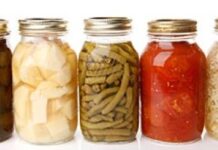by Dana Douglas, MScFN, RD, Registered Dietitian and Public Health Nutritionist
Before Heading to the Grocery Store
Successful grocery shopping begins before the grocery store. Start by making a meal plan and using this meal plan to create a grocery list. To develop your meal plan, take stock of the food you currently have in your refrigerator, freezer and pantry. Check flyers to see what’s on sale and consider incorporating some in-season fruit and vegetables as they’re cheaper and fresher. Pick meal ideas or recipes you know and like, or new ones you’d like to try. You may start with a full meal idea, or an ingredient and build the meal around it.
The plate model from Canada’s Food Guide is helpful when planning meals – aim to fill half your plate with vegetables and fruit, one quarter with whole grains, and one quarter with protein foods like meat, poultry, eggs, tofu, beans and legumes, cheese, yogurt, milk and unsweetened fortified soy beverage.
Be realistic when planning your meals and consider what you have time to prepare and cook. Some days and weeks are busier than others, so choose simpler meals when you have less time and consider incorporating leftovers when possible. For example, you may roast a small chicken for dinner one night, and use leftover chicken to make sandwiches for lunch the next day or a chicken and noodle casserole for dinner. Once the meal plan is finished, use it to develop your grocery list. Keep in mind the ingredients you already have and what you will need to purchase and in what quantity.
At the Grocery Store
To save money at the grocery store, stick to your grocery list and try not to stray from it. Avoid shopping on an empty stomach, as everything looks more delicious when we’re hungry and we’re tempted to buy foods we don’t necessarily need. Learn the regular prices of foods you buy often, as this will help you to decide which stores have the best price and if you’re getting a good price on sale items.
Learning how to navigate the various aisles in the grocery store can also help cut costs. Fresh foods such as produce, meat, poultry, fish and milk products are usually on the outside perimeter of stores, while more processed foods are in the inner aisles. Learning the layout of the store can help you avoid the aisles with products you don’t need. Look high and low on the shelves as the more expensive items are typically in the middle of the shelf at eye level.
Other budget conscious strategies include stocking up on pantry items and comparing the unit price of items. If you have space, stock up on basic pantry items like rice, pasta, canned products and dried beans when they’re on sale. Compare the unit price of similar items to see which is cheaper. The unit price indicates how much something costs per “unit” (per 100 grams or 100 millilitres). It is usually on the price tag, in small print under the main price.
For more information, visit the Health Unit’s website at www.healthunit.org, connect with us on Facebook and follow us on X @LGLHealthUnit.







